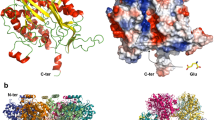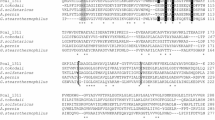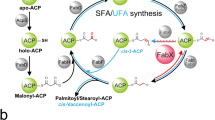Abstract
Helicobacter pylori is a microaerophilic bacterium, associated with gastric inflammation and peptic ulcers. d-Amino acid dehydrogenase is a flavoenzyme that digests free neutral d-amino acids yielding corresponding 2-oxo acids and hydrogen. We sequenced the H. pylori NCTC 11637 d-amino acid dehydrogenase gene, dadA. The primary structure deduced from the gene showed low similarity with other bacterial d-amino acid dehydrogenases. We purified the enzyme to homogeneity from recombinant Escherichia coli cells by cloning dadA. The recombinant protein, DadA, with 44 kDa molecular mass, possessed FAD as cofactor, and showed the highest activity to d-proline. The enzyme mediated electron transport from d-proline to coenzyme Q1, thus distinguishing it from d-amino acid oxidase. The apparent Km and Vmax values were 40.2 mM and 25.0 μmol min−1 mg−1, respectively, for dehydrogenation of d-proline, and were 8.2 μM and 12.3 μmol min−1 mg−1, respectively, for reduction of Q1. The respective pH and temperature optima were 8.0 and 37°C. Enzyme activity was inhibited markedly by benzoate, and moderately by SH reagents. DadA showed more similarity with mammalian d-amino acid oxidase than other bacterial d-amino acid dehydrogenases in some enzymatic characteristics. Electron transport from d-proline to a c-type cytochrome was suggested spectrophotometrically.






Similar content being viewed by others
Abbreviations
- DAD:
-
d-Amino acid dehydrogenase
- DadA:
-
DAD purified from recombinant Escherichia coli
- DCIP:
-
2,6-Dichlorophenolindophenol
- PMS:
-
Phenazine methosulfate
- SDS-PAGE:
-
Sodium dodecyl sulfate-polyacrylamide gel electrophoresis
References
Bradford MM (1976) A rapid and sensitive method for the quantitation of microgram quantities of protein utilising the principle of protein-dye binding. Anal Biochem 72:248–254. doi:10.1016/0003-2697(76)90527-3
Dixon M, Kleppe K (1965) d-Amino acid oxidase II. Specificity, competitive inhibitions and reaction sequence. Biochim Biophys Acta 96:368–382
Dunn BE, Cohen H, Blaser MJ (1997) Helicobacter pylori. Clin Microbiol Rev 10:720–741
Fischer L, Gabler M, Horner R, Wagner F (1996) Microbial d-amino acid oxidases (EC 1.4.3.3). Ann NY Acad Sci 799:683–688
Franklin FCH, Venables WA (1976) Biochemical, genetic, and regulatory studies of alanine catabolism in scherichia coli K12. Mol Gen Genet 149:229–237. doi:10.1007/BF00332894
Frisell WR, Hellerman L (1956) The sulfhydryl character of d-amino acid oxidase. J Biol Chem 225:53–62
Frisell WR, Lowe HJ, Hellerman L (1956) Flavoenzyme catalysis. Substrate-competitive inhibition of d-amino acid oxidase. J Biol Chem 223:75–83
Fukui K, Watanabe F, Shibata T, Miyake Y (1987) Molecular cloning and sequence analysis of cDNAs encoding porcine kidney d-amino acid oxidase. Biochemistry 26:3612–3618. doi:10.1021/bi00386a054
Kelly DJ (1998) The physiology and metabolism of the human gastric pathogen Helicobacter pylori. Adv Microb Physiol 44:137–189. doi:10.1016/S0065-2911(08)60131-9
Krishnan N, Becker DB (2006) Oxygen reactivity of PutA from Helicobacter species and proline-linked oxidative stress. J Bacteriol 188:1227–1235. doi:10.1128/JB.188.4.1227-1235.2006
Laemmli UK (1970) Cleavage of structural proteins during the assembly of the bacteriophage T4. Nature 227:680–685. doi:10.1038/227680a0
Łobocka M, Henning J, Wild J, Kłopotowski T (1994) Organization and expression of the Escherichia coli K-12 dad operon encoding the smaller subunit of d-amino acid dehydrogenase and the catabolic alanine racemase. J Bacteriol 176:1500–1510
Marshall VP, Sokatch JR (1968) Oxidation of d-amino acids by a particulate enzyme from Pseudomonas aeruginosa. J Bacteriol 95:1419–1425
Menzel R, Roth J (1981) Enzymatic properties of the purified putA protein from Salmonella typhimurium. J Biol Chem 256:9762–9766
Nagata K, Nagata Y, Sato T, Fujino A, Nakajima K, Tamura T (2003) l-Serine, d- and l-proline and alanine as respiratory substrates of Helicobacter pylori: correlation between in vitro and in vivo amino acid levels. Microbiol 149:2023–2030. doi:10.1099/mic.0.26203-0
Nagata Y, Sato T, Enomoto N, Isii Y, Sasaki K, Yamada T (2007) High concentrations of d-amino acids in human gastric juice. Amino Acids 32:137–140. doi:10.1007/s00726-006-0262-9
Olsiewski PJ, Kaczorowski CJ, Walsh CT (1980) Purification and properties of d-amino acid dehydrogenase, an inducible membrane-bound iron-sulfur flavoenzyme from Escherichia coli. J Biol Chem 255:4487–4494
Raunio RP, Straus LP, Jenkins WT (1973) d-Alanine oxidase from Escherichia coli: Participation in the oxidation of l-alanine. J Bacteriol 115:567–573
Ronchi S, Minchiotti L, Galliano M, Curti B, Swenson RP, Williams CH Jr, Massey V (1982) The primary structure of d-amino acid oxidase from pig kidney. II. Isolation and sequence of overlap peptides and the complete sequence. J Biol Chem 257:8824–8834
Saito M, Nishimura K, Hasegawa Y, Shinohara T, Wakabayashi S, Kurihara T, Ishizuka M, Nagata Y (2007) Alanine racemase from Helicobacter pylori NCTC 11637: purification, characterization and gene cloning. Life Sci 80:788–794. doi:10.1016/j.lfs.2006.11.005
Satomura T, Kawakami R, Sakuraba H, Ohshima T (2002) Dye-linked d-proline dehydrogenase from hyperthermophilic archaeon Pyrobaculum islandicum is a novel FAD-dependent amino acid dehydrogenase. J Biol Chem 277:12861–12867. doi:10.1074/jbc.M112272200
Scarpulla RC, Soffer RL (1978) Membrane-bound proline dehydrogenase from Escherichia coli. J Biol Chem 253:5997–6001
Tsuda M, Karita M, Morshed MG, Okita K, Nakazawa T (1994) A urease-negative mutant of Helicobacter pylori constructed by allelic exchange mutagenesis lacks the ability to colonize the nude mouse stomach. Infect Immun 62:3586–3589
Tsukada K (1966) d-Amino acid dehydrogenases of Pseudomonas fluorescence. J Biol Chem 241:4522–4528
Wild J, Walczac W, Krajewska-Grynkiewicz K, Klopotowski T (1974) d-Amino acid dehydrogenase: the enzyme of the first step of d-histidine and d-methionine racemisation in Salmonella typhimurium. Mol Gen Genet 128:131–146. doi:10.1007/BF02654486
Acknowledgments
We would like to express our thanks to Dr. K. Nagata (Department of Bacteriology, Hyogo College of Medicine) for providing H. pylori NCTC 11637 strain and useful advice for culture.
Author information
Authors and Affiliations
Corresponding author
Additional information
Database
The sequence of H. pylori NCTC 11637 gene dadA reported in this paper has been submitted to DDBJ, GenBank ™ and BBI databanks under accession No. AB295062 (NCBI accession No. BAF48065).
Rights and permissions
About this article
Cite this article
Tanigawa, M., Shinohara, T., Saito, M. et al. d-Amino acid dehydrogenase from Helicobacter pylori NCTC 11637. Amino Acids 38, 247–255 (2010). https://doi.org/10.1007/s00726-009-0240-0
Received:
Accepted:
Published:
Issue Date:
DOI: https://doi.org/10.1007/s00726-009-0240-0




